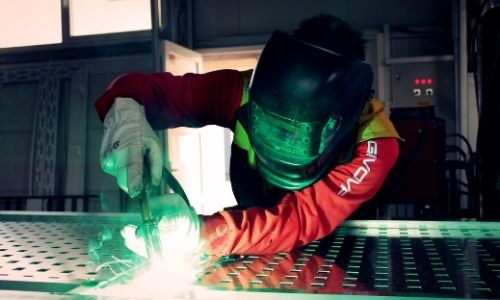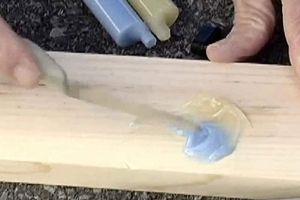If you’re a DIYer with interests in metals, you might need to do welding every now and then. But not each of us would spend hundreds of bucks after a welding machine anyway. For occasional uses, that’s kind of a waste of money.
If that’s you, the obvious question popping up in your mind is- how to weld at home without a welder?
The most popular method of welding at home is brazing. All you’ll need is a propane torch, wood filer and bazing rod. First, clean the metals you want to weld and place them accordingly. Next, join two pieces of metals with the heat from a propane torch and rub the brazing rod around the joints. It would fuse the subjects together.

These were the nitty-gritty of welding at home without a welder. If you want more details on the steps of welding then do give this a quick read.
Are you ready?
4 Ways You Can Weld At Home without Welder
Welding means joining two pieces of metal by melting them at melting point temperature. This allows the metals to fuse together after cooling down. Welding with a welder requires a lot of time and experience. You will also need heavy industrial equipment which can prove costly.
Welding industrially is not very convenient or ideal for people who build as a hobby. So welding at home with a welder is not the best option. And welders are not safe to work with. However, there are a good number of alternatives to welding you can try out at home.
Many say welding is an art. And that it needs experience and patience. However, if you want a quick way of joining stainless steel without welding for a project or experiment there are options for you to weld without a welder. Do you know which tool bag is best for welder?
2 Ways for Amateurs to Weld Without Welder
No.01: Using Nanomaterial
This is a new method of joining pieces of metals without any welders. It’s still being developed and experimented. But the method has proved very useful in this case.
In this process of using nanomaterials, you need to make the surface of the metal rough. This is done using a special etching method. In this etching method, different electro chemicals are used along with 3D printing.
The metals that go under this process forms a nano hook-like structure. The metal pieces are later on glued together forming a strong bond.
Pros
- This process does’nt require high temperature and can be conducted in room temperature. So it’s not as risky as the heating methods. The bond of the metals are very strong. This method can be used for building ships or cars.
Cons
- Nanomaterial is still a new process. It has not been tested in a wide range. A lot of the countries still don’t have easy access to 3D printers.
No.02: Using Glue
This is one of the simplest hacks of joining two pieces of metal together. It doesn,t require heating or a 3D printer. All you have to do is apply a good coat of adhesive or epoxy instead of welding the metals, and you’re good to go.
Though if I were you I wouldn’t apply adhesive on metals that will carry loads. Because a glue cannot create a bond as strong as any fusing methods. Although there are products developed for joining metals with a robust bond. Some of them are-
- Silicon based adhesive
- epoxy
- Polyurethane
- Double-sided tape
Some of the new products contain microscopic nanorods with various metallic cores. These metallic cores are fused together when joining the metals which creates a strong bond.

Here are some of our recommendations of metal adhesive that’ll add two pieces of metal as good as welding machine-
- J-B Weld 8265S Original Cold-Weld Steel Reinforced Epoxy
- WEST SYSTEM G/Flex Epoxy
- Gorilla 2 Part Epoxy
Pros
- This is the most inexpensive way of welding metals. What’s more, using adhesive involves less risk. So the precaution for using glue is minimum.
Cons
- Not all metals can be glued together. Especially the ones that are used for carrying loads and requires much stronger bonds. So, using adhesive is not always the best option.
2 Ways for Semi-professional Welding Without Welder
In case you’re neither a professional nor an amateur, we’ve got a couple of ways to join two pieces of metals without welding machines at home.
No.01: Soldering
Soldering is an interesting way to join two metal pieces. Because in this process, no mechanical bond is required to join the metals. Instead the metals are joined using electrical bonds.
In this process the solder, a coiled wire made of metal alloy (a mixture of metals), is melted and used to join two metal pieces. This alloy melts at a very low temperature due to it’s composition. Solder is made of 99% tin. And the rest can be any one of these metals-
- copper
- silver
- zinc
- bismuth
Instead of heating and melting the metals that we want to weld, soldering melts the metal fillers which helps the two peices to fuse.

If you decide that soldering is a way to go, here i would recommend ANBES Soldering Iron Kit Electronics kit for you if you have smaller jobs at hand.
Pros
- Soldering is safer than welding since it requires heating with very low temperature to bond the metal pieces. Soldering, for it’s electrical bonding, is mostly used in electrical circuits.
Cons
- Electrical bonds are not as strong or reliable as the mechanical bonds. So it cannot be applied to metals for lifting or loading purposes.
No.02: Brazing
This process is similar to welding or soldering. Because this also requires heating the filler rod for joining metal. However, brazing creates a much stronger bond. And does not require a lot of time. That’s why brazing is the most popular method of welding metals without welder.
The filler metal for brazing acts as the adhesive to attach the metals. They can be composed of any one of the following components-
- Copper-phosphorus
- Silver
- Aluminum-silicon
- Magnesium
- Cobalt
- Nickel
- Precious alloys

In the process of brazing, the metal as well as the filler metal melts and fuses to secure their bond. This means the temperature for brazing is higher than soldering.
Pros
- Brazing is a process somewhere in between welding and soldering. So it creates almost as strong a bond as welding. Although the temperature for brazing is lower than that of welding.
Cons
- As the filler metal is softer than any normal metal, the bond is not as reliable as welding.
These are some of the alternate methods of welding without welder. The benefit of using the alternate method is that it save you a lot of money and allows you to experiment with your project. Now make sure you choose the methods depending on the purpose of your project and the usage of the metals.
Let us take a quick look at the steps of welding at home-
3 Steps of Brazing: Our Favorite Way of Welding Without Welder
The most popular method of welding at home is brazing. It’s simple and doesn’t require a lot of safety measures. If you want to join metals without welding, simply follow our our step by step guide. You’ll have your metals welded in no time!
Before you jump into the steps, make sure you have all the proper tools with you. Or else your work flow will be disrupted.
Tools
- Propane torch (Blue Bernzomatic or Yellow Premium Touch )
- Brazing Rod/Welding Rod
- Wood File
- The metal pieces
- Wire Brush
Step 1:
The first step of welding would be to chamfer the piece of metal you want to join with a wood file. This allows to create a channel for the brazing rod. After chamfering the pieces, brush them with a wire brush. Cleaning the metal before welding is important for a better output.
Step 2:
The next step would be to place the pieces of metal that you want to weld. After that heat the welding place of the metal using a propane torch.
Here’s some of the popular propane torch we recommend for your welding-
This step requires safety measures. So make sure you practice using the torch before hand.
Step 3:
Once you’re done heating the metal, take the brazing rod and rub it around the junction of the two metals. If needed you can use the propane torch to heat the rod again. The brazing rod needs to be placed evenly around the joints so that the metals bond firmly.
This process requires some test and trials. You might get some ugly metal joints but we promise it will get better with each time.
You can see about Use Argon For MIG Welding or Not?
People Also Ask About How To Weld At Home Without A Welder
Is there a way to weld without welder?
Yes there is! There are many alternate methods to weld without welder. Some of these methods are soldering, using adhesives, brazing, and by using nanomaterial. You can also try out riveting your metals.
What is the easiest form of welding to learn?
There are many easier alternates to welding. The easiest and quickest process of welding is using adhesives. But if you want to learn a welding process, in our opinion, brazing is the most easier and popular method to learn.
What can I use to attach metals without welding?
There are many options. Some products are developed for joining metals without having to use a welder. Such as adhesives based on silicone and epoxy glue. There are also some double sided tapes for this purpose. If you want a more permanent solution you can go fot the riveting process.
Signing Off
People often prefer welding without welding when joining two metals. You’ll need to determine the purpose of the metals before going for any of the metals. And take all sorts of precautions for welding, we don’t want you to burn yourself.
Let us know which of the method you are going for and your experience using it. Till then, keep buiding!
